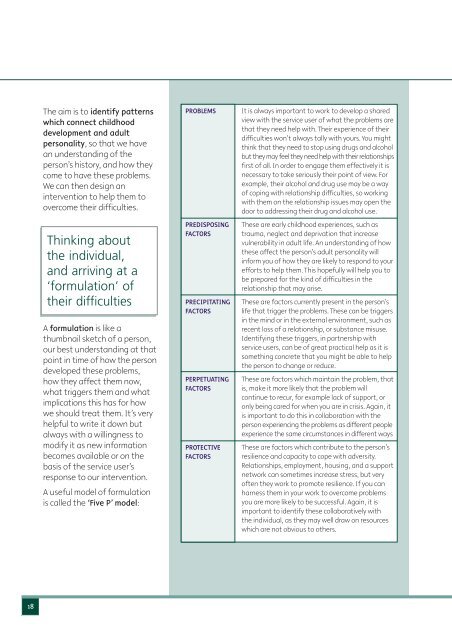Meeting-The-Challenge-Making-a-Difference-Practitioner-Guide
Meeting-The-Challenge-Making-a-Difference-Practitioner-Guide
Meeting-The-Challenge-Making-a-Difference-Practitioner-Guide
You also want an ePaper? Increase the reach of your titles
YUMPU automatically turns print PDFs into web optimized ePapers that Google loves.
<strong>The</strong> aim is to identify patterns<br />
which connect childhood<br />
development and adult<br />
personality, so that we have<br />
an understanding of the<br />
person’s history, and how they<br />
come to have these problems.<br />
We can then design an<br />
intervention to help them to<br />
overcome their difficulties.<br />
Thinking about<br />
the individual,<br />
and arriving at a<br />
‘formulation’ of<br />
their difficulties<br />
A formulation is like a<br />
thumbnail sketch of a person,<br />
our best understanding at that<br />
point in time of how the person<br />
developed these problems,<br />
how they affect them now,<br />
what triggers them and what<br />
implications this has for how<br />
we should treat them. It’s very<br />
helpful to write it down but<br />
always with a willingness to<br />
modify it as new information<br />
becomes available or on the<br />
basis of the service user’s<br />
response to our intervention.<br />
A useful model of formulation<br />
is called the ‘Five P’ model:<br />
PROBLEMS<br />
PREDISPOSING<br />
FACTORS<br />
PRECIPITATING<br />
FACTORS<br />
PERPETUATING<br />
FACTORS<br />
PROTECTIVE<br />
FACTORS<br />
It is always important to work to develop a shared<br />
view with the service user of what the problems are<br />
that they need help with. <strong>The</strong>ir experience of their<br />
difficulties won’t always tally with yours. You might<br />
think that they need to stop using drugs and alcohol<br />
but they may feel they need help with their relationships<br />
first of all. In order to engage them effectively it is<br />
necessary to take seriously their point of view. For<br />
example, their alcohol and drug use may be a way<br />
of coping with relationship difficulties, so working<br />
with them on the relationship issues may open the<br />
door to addressing their drug and alcohol use.<br />
<strong>The</strong>se are early childhood experiences, such as<br />
trauma, neglect and deprivation that increase<br />
vulnerability in adult life. An understanding of how<br />
these affect the person’s adult personality will<br />
inform you of how they are likely to respond to your<br />
efforts to help them. This hopefully will help you to<br />
be prepared for the kind of difficulties in the<br />
relationship that may arise.<br />
<strong>The</strong>se are factors currently present in the person’s<br />
life that trigger the problems. <strong>The</strong>se can be triggers<br />
in the mind or in the external environment, such as<br />
recent loss of a relationship, or substance misuse.<br />
Identifying these triggers, in partnership with<br />
service users, can be of great practical help as it is<br />
something concrete that you might be able to help<br />
the person to change or reduce.<br />
<strong>The</strong>se are factors which maintain the problem, that<br />
is, make it more likely that the problem will<br />
continue to recur, for example lack of support, or<br />
only being cared for when you are in crisis. Again, it<br />
is important to do this in collaboration with the<br />
person experiencing the problems as different people<br />
experience the same circumstances in different ways<br />
<strong>The</strong>se are factors which contribute to the person’s<br />
resilience and capacity to cope with adversity.<br />
Relationships, employment, housing, and a support<br />
network can sometimes increase stress, but very<br />
often they work to promote resilience. If you can<br />
harness them in your work to overcome problems<br />
you are more likely to be successful. Again, it is<br />
important to identify these collaboratively with<br />
the individual, as they may well draw on resources<br />
which are not obvious to others.<br />
18


